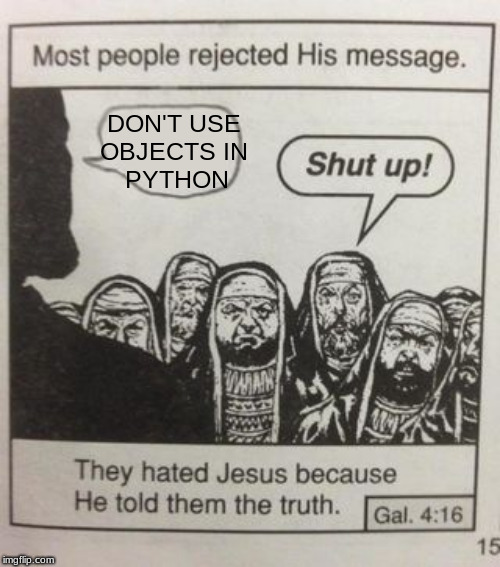So my previous blog posts, were posted on reddit and I got a lot of interesting feedback. I’ve decided to address the issues that were brought up all together in one place, and this is it! I’ve grouped all the different ideas that came up into their own sections below.

This is against community guidelines
Some people were upset that what I recommended was against the community guidelines. They’re correct, it is. However that isn’t really an argument against doing something. Community guidelines and standards aren’t some holy scripture that must always be obeyed. The entire point of my post was that the common usage of object orientation of Python is bad, I doubt there is anyway I could say that without also advocating against the normal Python standards. There is certainly some value in educating people about community standards, but the value of an idea cannot be reduced to how compliant it is with Python coding guidelines.
Dictionaries are Actually Objects
So a couple of people pointed out that internal to python there is inheritance, and that datatypes like Dictionary actually inherit from the Python Object type. Sure, that’s fine, I don’t have a problem with how the internals of Python implement the various data structures. Indeed the internals are overwhelmingly written in C, so it is not at all relevant, when we’re talking about actual Python code.
Objects are Abstractions of Python Dictionaries
Some commenters argued that Objects in Python are abstractions sitting on-top of dictionaries. This just isn’t true. An abstraction hides the details below it. For example, variables are an abstraction that hide the details of how registers and memory access actually work. Because they limit what you see and what you can do, they make using memory a lot easier. Python objects don’t hide any of the details of a dictionary, they are just syntactic sugar, all the operations of a normal python dictionary are available right their on the object with slightly different syntax, you can even access the dictionary itself with the __dict__ attribute. So this isn’t really true.
It’s all just an implementation Detail
So a few people took issue with the fact that I was talking about the specifics of how objects and classes are actually implemented, rather than talking about them in an abstract sense. I think this has missed the point. I am not quibbling with how objects are implemented. My point is that objects don’t give any extra functionality beyond using dictionaries. I brought up the implementation as a way to demonstrate this. My point doesn’t rest on the fact that there is an actual dictionary internal to objects. It rests on the fact that objects are really just a collection of attributes with string names, these attributes can be added, deleted and modified at run time, and that there really isn’t anything more of value in the Python Object. The fact that this collection of attributes is implemented by a dictionary specifically isn’t important.
In particular some people stressed that what I was talking about was just an implementation detail unique to CPython, and that somehow it is different in some other Python implementation. I can’t stress this enough, it doesn’t matter what the actual implementation of the attributes of an object are, it is still bad. But also, no-one actually uses PyPy, Jython or IronPython. They are basically irrelevant.
Having methods defined on types is Convenient
I think this was probably the best point raised. I concede that if you want to maintain some state, and mutate it at runtime, it is convenient to wrap that state in an object and have specific methods defined on that object. The alternative is to just store your state using some built in types and operate on it with functions. However, what it seems you really want to do, restrict functions to only work with specific types, is to use static types. This seems like a roundabout way to achieve that. If you want static typing, you’re not going to be happy with Python. Really what you are doing here, is associating certain bits of data and functionality, like in an object oriented language, but without any guarantee of what the data actually is.
Python Objects are Different if you use __slots__
A lot of people brought up __slots__. Yes, if you use the __slots__ attribute Python objects work differently and my criticism doesn’t apply exactly. But, by default, python objects don’t use __slots__. The default implementation is actually pretty important, because it’s the one that is going to get used most often. In fact I’ve never seen someone use __slots__, I’ve only ever come across it as an obscure trick that gets recommended for python experts. It’s not a robust defence of a language feature to say, “actually there’s this special thing you can do that totally changes how it is implemented”. That’s really a sign that the default implementation is not good.
So __slots__ does change how objects work, and makes them a lot less like a special wrapper around a simple dictionary. But I don’t think it resolves any of the fundamental problems with using objects in Python. They are basically just a collection of attributes, we cannot say anything about them apart from how many attributes there are and what their names are. In particular they don’t specify the shape of the data.
One benefit of __slots__ is that your objects will use memory more efficiently. I would say, however, that you shouldn’t be worrying about memory optimisations like this in a high level language. Also, if there are memory optimisations in your language they shouldn’t be controlled in an opaque unintuitive way like the __slots__ attribute.
